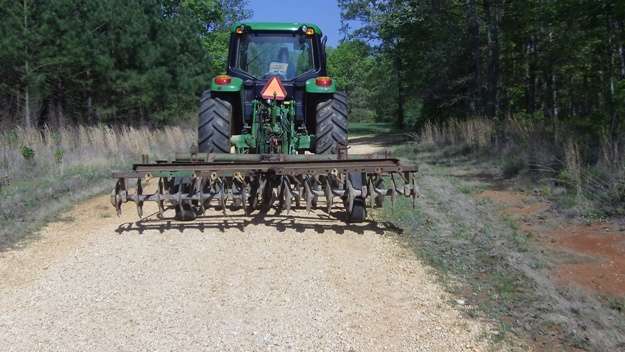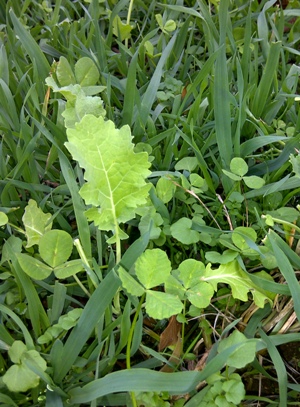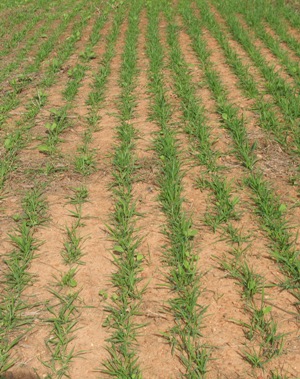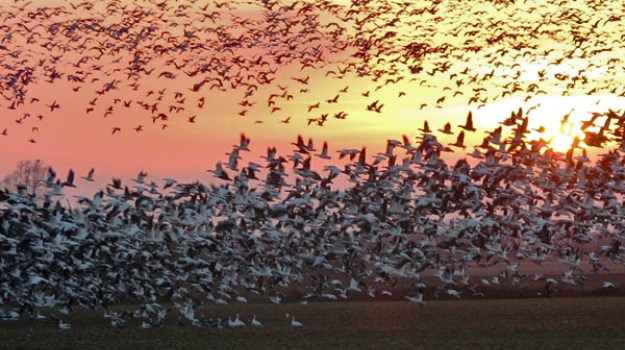
Ensure Success despite the Hot, Dry Conditions of Fall Planting
By Austin Delano
Let’s face it, sometimes planting during the late summer through the early fall can be tough. The ideal planting time for cool season food plots coincides with some of the driest months of the year (July-October) and topsoil moisture, or the lack of it, will be the most important detail in the success, or failure of your plots. With the northern part of the country the exception because of the jet stream and ocean temperatures, much of the country starts seeing the summer thunderstorm frequency “dry up” around the first of August, and the southern part of the country doesn’t begin to receive any reliable rain events until October. With many landowners, hunting clubs, and outfitters planting in August and September, the conditions can be very challenging to say the least. How can a land manager assure themselves of some cool season cuisine for their herd?
 With the absence of rain in the forecast and soil moisture being almost non-existent, a lot of folks will have fields that are not up and growing until late fall. Not having a nice, lush, tender field to hunt over on opening day of bow season seems like the worst thing to some hunters, but don’t give up yet. Late planted plots can be plenty effective for attracting deer and also providing cold season nutrition. If you run into a dry planting season following are a few points to consider that should help you grow a successful crop under adverse conditions.
With the absence of rain in the forecast and soil moisture being almost non-existent, a lot of folks will have fields that are not up and growing until late fall. Not having a nice, lush, tender field to hunt over on opening day of bow season seems like the worst thing to some hunters, but don’t give up yet. Late planted plots can be plenty effective for attracting deer and also providing cold season nutrition. If you run into a dry planting season following are a few points to consider that should help you grow a successful crop under adverse conditions.
Try to have your ground ready to disk or till, but don’t turn the soil over until you have to. Even if the top few inches of dirt is dry, you can conserve valuable soil moisture 5-10 inches down by waiting to work your ground and broadcast seed just prior to a rain. Every time you turn the soil valuable topsoil moisture is lost.
Seeds that lay on top of the ground for extended periods of time without moisture can lose their germination rate. If you are a preparing to plant a field that is not currently in a crop, but is fallow or full of weeds, burn the field down ahead of time with a non-selective herbicide. After waiting a week to ten days after spraying the soil will be easier to work and require less passes with equipment to achieve a proper seed bed. Multiple passes when tilling or repeated disking can steal valuable soil moisture from your topsoil. Being able to create an acceptable seedbed in as little as one pass will go a long way in helping to conserve soil moisture.
If you are broadcasting your seed using a disk, field cultivator, or tiller box works well to create a seed bed perfect or maximum seed to soil contact. Sometimes using this equipment can leave you with a nice and smooth but “fluffy” seed bed. This is when using a cultipacker or roller can really be advantageous, for a couple reasons. Cultipacking will firm-up your seed bed and create great conditions for clovers, brassicas, chicory and other small seeds to be broadcast upon. Using a cultipacker before and after broadcasting will create great seed to soil contact and help seal in any soil moisture that might be present.
 Using a no-till drill can also be a life-saver when planting in dry fall conditions. A no-till drill can place wheat, oats, triticale, in the ground at just the right depth without turning the ground over and losing precious soil moisture. Most drills disturb the soil just enough to make good seed to soil contact for small seeds such as clovers, chicory, or brassicas. I have had some very successful plots that were first drilled with oats and then broadcasted a half-rate of a brassica blend, such as Maximum, over the top. This way, even if the cold temperatures come a little early you will have a good stand of brassicas and if temperatures stay mild your cereal grains will have time to take off.
Using a no-till drill can also be a life-saver when planting in dry fall conditions. A no-till drill can place wheat, oats, triticale, in the ground at just the right depth without turning the ground over and losing precious soil moisture. Most drills disturb the soil just enough to make good seed to soil contact for small seeds such as clovers, chicory, or brassicas. I have had some very successful plots that were first drilled with oats and then broadcasted a half-rate of a brassica blend, such as Maximum, over the top. This way, even if the cold temperatures come a little early you will have a good stand of brassicas and if temperatures stay mild your cereal grains will have time to take off.
If a late planting is in order because of abnormally dry conditions, make sure you know what to expect out of the specific seeds you are putting in the ground and understand it will be a potentially short growing season. Cool season perennials that are planted late may produce very little above ground growth. Perennials such as clovers and alfalfa will first build a good root system before it produces a lot of forage. It may be spring before you see these late perennial plantings come to life so you need to be sure and plan for that ahead of time. Cool season annuals like cereal grains, brassicas, winter peas, and annual clovers can produce great forage in a short period of time. I like to use blends such as Outfitters Blend, Full Draw, and Green Patch Plus that can put on a lot of growth fast.
Some managers like to work the soil and prepare their seedbed well in advance of planting and then keep competition at bay with an herbicide until planting time. This way no topsoil moisture is lost at planting time and beneficial microorganisms and nematodes that are killed each time the soil is worked have a chance to repopulate. One month ahead of planting is enough time to let your native seed bank germinate so that you can catch and kill any plants that may have germinated, but some choose to do this many weeks in advance and watch carefully for competition to arise. This technique is popular with people who are claiming new ground or those who have an active native seed bank because it gives you a chance to kill any unwanted competition that may have been inadvertently planted by you from working the soil. Since the last thing you do before planting is treating with an herbicide it tends to produce a very clean stand.
Soils that are high in clay content or have had years of heavy equipment tracking across them can be more susceptible to dry conditions. One thing that can be done every few years to give plants a stronger and deeper root system is sub-soiling. Topsoil in food plots that has a hard pan can dry out much quicker during dry conditions than those that have been recently sub-soiled. Sub-soiling allows moisture to penetrate deeper instead of hitting a hard pan and running off or drying up. This allows roots from planted crops to run deeper and access this moisture as well as minerals and nutrients that were not available before sub-soiling. These deeper root systems can be especially beneficial during drought and high temperatures.
Split applications of fertilizer also tend to be very effective on later planted plots. A late planted field that experiences some cold weather or frosts soon after germination can often greatly benefit from a secondary fertilizer application 30 -45 days after germination. This can really make your plots take off, especially if there is a warm spell a bit later in the fall. If Mother Nature cuts off the water hose this fall, use these tips to make the most out of your late planting.






























